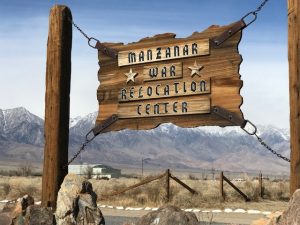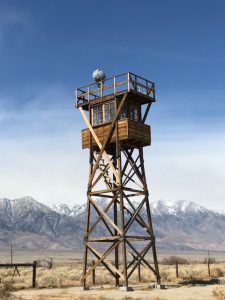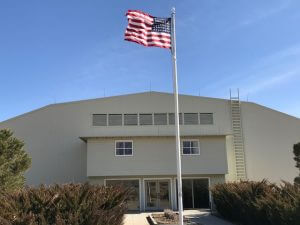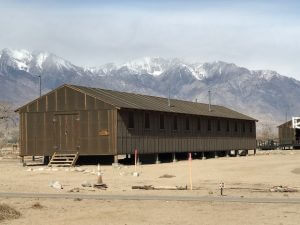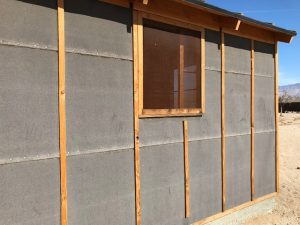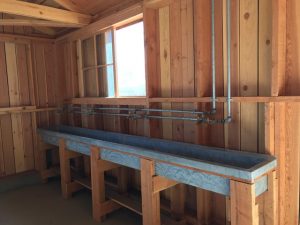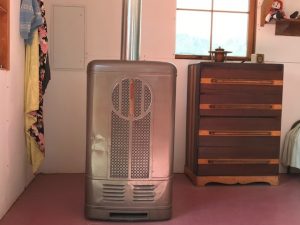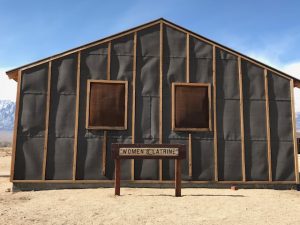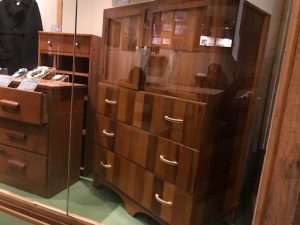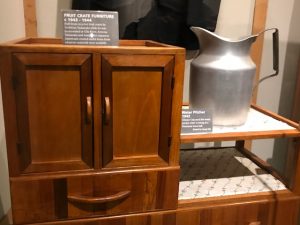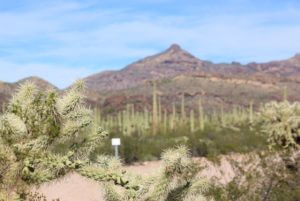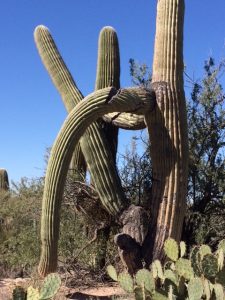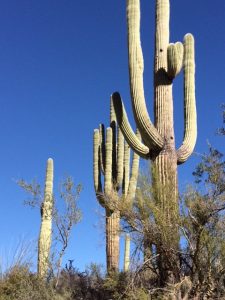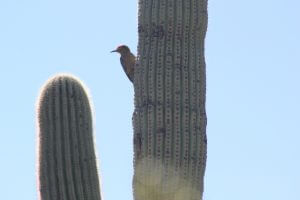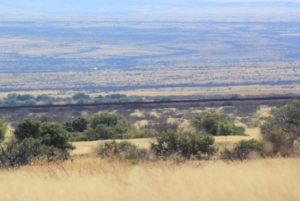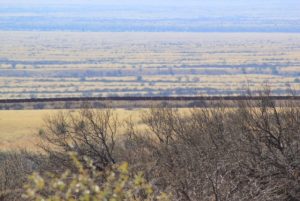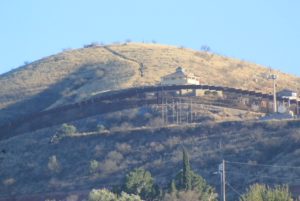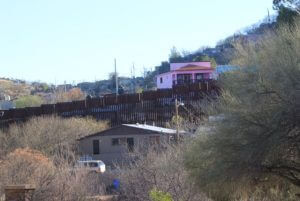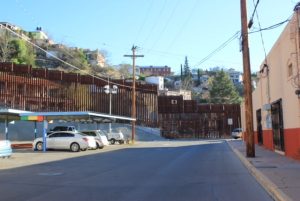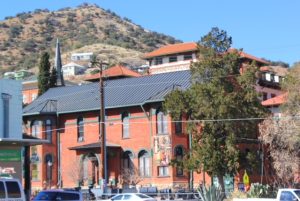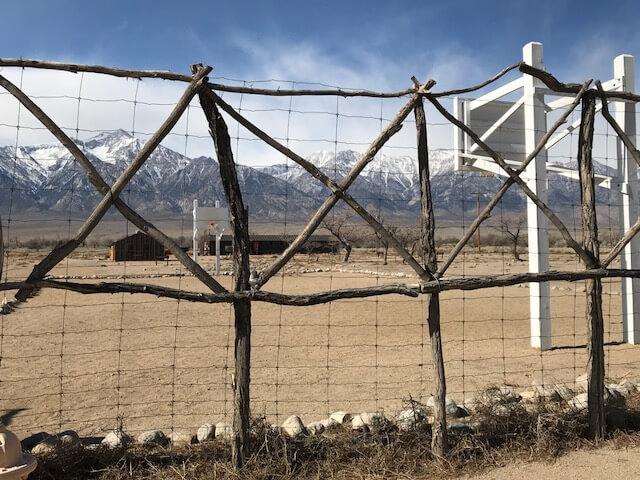
Manzanar: Let It Not Happen Again
In 2012, I visited Auschwitz. One heart-wrenching day was enough to quell my curiosity about internment camps forever. Then last week, my husband insisted on seeing The War Relocation Center at Manzanar in central California, near Death Valley. It is now part of our wonderful, educational National Park Service.
In this one-square-mile internment camp, the American officers were less physically cruel than the Nazis in Poland, but the gross unfairness should disturb everyone. Many Japanese were American citizens (Nissei). Some were Japan-born (Issei). But for all, as Ronald Reagan said, “It was an action taken without trial, without jury. It was based solely on race…”
Today, we must still heed the message of Manzanar, stated in the Visitor Center video:
“When we violate the Constitution, we [as a country] start to unravel.”
Originally, FDR thought internment was unconstitutional, but in 1942, his sentiments lost out to a propaganda war pushing known falsehoods. Imagine, Americans willing to believe what they know is a lie.
Rounded up without warning, Japanese families from all over the West coast left almost everything behind. Worse yet, the government sold their property to pay for the internment. To further finance their own internment, Japanese residents farmed to grow their own food.
Manzanar’s location in a mountain valley brings brutal weather, sweltering heat in the summer, blistering cold in the winter and unrelenting winds all year (a march wind blows in the photo below), with everything constantly covered in dust.
The Japanese first lived in 504 crowded barracks with tar paper insulation. Don’t know how they survived.
Eventually, they obtained furnaces and sheetrock.
For a modest, humble people, the lack of privacy was humiliating. One woman said her mother waited until the middle of the night to go to the communal shower room.
In Auschwitz, the toilet was one long trough. Prisoners straddled it while the guards said, “One, two, three, pee pee.” After thirty seconds, guards called, “Next.” Here are the toilets in Manzanar. Not a trough, but would you be comfortable with this situation?
Through all the hardship, the Japanese spirit survived, and to my surprise, so many internees remained patient and patriotic. Some men even joined the U.S. Military.
What I most wanted to see was any sign of the triumph of the human spirit. If you saw Life Is Beautiful, you remember the music. So at Manzanar, I searched for art and beauty.
The Japanese men became skilled carpenters and crafted beautiful furniture from fruit crates.
I saw videos of women in lovely Japanese gardens, but when I searched the landscape, this is what I found.
After the war, the U.S. Government razed the structures to sell the wood, and they also buried the Japanese gardens, which made my heart sad.
The American spirit also revived. In 1988 Ronald Reagan signed a bill providing restitution for “this grave mistake.” Monuments have been erected as reminders, like the Nidoto Nai Yoni Memorial on Bainbridge Island. Here, on the memorial wall, you will find an ugly history among art, nature, and beauty. You will also find a translation: “Let it not happen again.” To appreciate this beauty, follow this link.

Six Ways to Fly Healthy during Flu Season
We in the Pacific Northwest don’t travel during the summer when the cloudless sky is a warm and dreamy blue. We fly away during flu season when the charcoal clouds burst with rain and the airline passengers burst with germs.
At the Women’s March on Saturday, one of my friends complained of a cough lingering six weeks after she contracted the nasty Australian flu on a trip to Puerta Vallarta. So, at lunch, my traveler friends shared techniques on how to stay healthy when flying during flu season.
If you, too, will be up in the air soon, check out their tips. I’m not guaranteeing anything. If you ask a doctor, she’ll say get the flu shot and fly healthy. But it seems like a little extra effort may go a long way.
1. Sanitizer wipes
My friend, Laura, carries a pack of sanitizer wipes and sanitizes her whole seating area. This includes the armrests, seatbelt, touch screen, and tray table. Don’t forget the remote, if you have one. And while you’re at it, wipe your hands, especially before eating.
2. Mask
If you can prioritize health over fashion, cover your nose and mouth with a gauze mask throughout the flight. If you have ever flown in Asia during an epidemic of the flu or SARS, you’ll notice only the handful of foreign passengers are not masked.
Some people prefer coating the inside of their noses with Vaseline or an antibiotic or anti-sporin ointment, thinking the thick goop will block or catch germs. I Googled this technique and online medical people don’t recommend it. They say, you still have to breathe, so germs will get in. Plus, the flu is a virus and is not bacterial, so the ointment won’t kill anything.
3. Nasal Spray
Here’s a new idea I might try. The dry in-flight air prevents your nose from functioning as a germ catcher. Use a saline nasal spray to make sure the inside of your nose is hydrated and working for you.
I do travel with a netty pot and always start a saline nasal rinse at the first sign of congestion.
4. Overhead Air Blower
Because of my dry eye syndrome, I avoid fans. However, my friend, Jes, just flew to Bangkok, and her doctor recommended using the overhead fan to create a protective cone around her body, to blow the germs to the side and down. She returned healthy and remains so.
5. Lavatory
My friend, Bill, never books a seat by the restrooms. Who knows what floor germs people track into the aisle when they leave. He also doesn’t like people coughing on him while they wait in line.
I hope you wear shoes in the lavatory. So many people go in socks. When you enter or leave, make sure to touch the door handle with a tissue or your elbow, not bare skin.
6. Vitamin C
Vitamin C, in the form of Emergen-C or Airborne, works for me at this time of year. When flying, I take it before, during, and after.
Other Problems
Just a reminder from my friend, Janet. Whenever you fly, consider using compression socks and doing the calf exercises the airlines show on the screen. The one time Janet didn’t, her flight was grounded during a storm, and hours of immobility turned into months of prescription drugs.
Janet shops at AAA and has certainly found a more attractive pair of socks than what I found at my local pharmacy.
Happy Travels. See you in the sky.
___________________________________________________
The feature image is by Mike Kanert and can be found on Creative Commons.
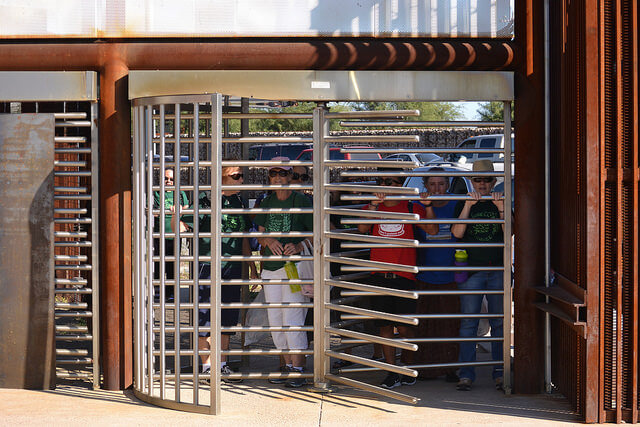
Ride Along Arizona’s Southern Border
I thought talk of building the wall would end quickly, but since it hasn’t, I went to southern Arizona and drove along the border, from Organ Pipe to Bisbee, to see what was what.
Heading from Tuscan to Organ Pipe, we passed through this small town. And I must say, the question asked in the town’s name remained with me the whole trip. (Okay, so Why refers to a fork in the road. How was I to know?)
Organ Pipe Cactus National Monument
Before I show you the border wall, I have to show you a very special place we visited kind-of on the way to Nogales.
Organ Pipe is a Biosphere Reserve set up by UNESCO in 1976 to preserve the ecosystem of the Sonoran Desert for humanity as well as for scientists. On a hike or drive you can see 26 species of cactus.
After Organ Pipe, we passed many miles of border wall. Parts are still barbed wire, others look more natural and blend in with the scenery. We only found this section below because a Park Ranger told us where to look.
These walls appear lower than what we saw in Nogales, as the area between the west and Nogales relies heavily on the U.S. Border Patrol. Checkpoints on the highway appear often.
Nogales, Arizona
Highway 19 is a major north/south trade route through Arizona and ends at Nogales, where the road crosses the border and becomes Federal Highway 15, El Camino Real, in Nogales, Mexico. On the way into town, we drove past many—too many—insurance sales offices. Insurance to buy before you cross into Mexico. The necessity for such a business told me to be wary about crossing over.
Nogales means walnut, the name derived from the walnut trees that used to line the pass between Ambos Nogales, both Nogaleses. Now, all we saw on the hillside was metal border walls.
In town, I walked up to the wall and got a queazy prison feeling, maybe due to the 4-inch space between bars (aka rusty poles). It brought back the eerie feeling of crossing the Berlin Wall in 1984.
Nevertheless, Nogales is a friendly place, so I asked people in our hotel restaurant how they felt about it. From a small sampling of residents, the Gringos and the Latinos are happy with life in Nogales but find the wall ugly. Most aren’t sure how well it works. After it was first erected in 2011, traffickers tunneled under. Now they sometimes climb over.
Everyone else walks through. “It’s easy,” the diners said. “Americans cross to Mexico for better, cheaper food and alcohol and for affordable dental care. Mexicans cross to the U.S. for Walmart. No problem. You should cross.”
Instead, we shopped on the U.S. side at places where we could understand the Spanish product names but did not recognize the brands. Though Nogales, Arizona became part of the U.S. with the Gadsden Purchase in 1853, it still feels like part of Mexico.
The tall Nogales wall only runs for ten miles and then dwindles to small walls or patrol areas.
We continued east to Bisbee, Arizona, a cute, historic copper mining town, which is very proud of its native daughter, renowned mystery writer, J.A. Jance.
The School House Inn is a comfortable and elegant BnB with interesting guests, a mountainside view, and a fantastic breakfast. Our bedroom used to be the history classroom.
From Bisbee we took a quick side trip to Tombstone, which is expensive and touristy. I will stop at just telling you Tombstone is still there.
So back to my question of Why? Now that illegal immigration has been down for a while, why is it necessary to build the biggest, shiniest, most beautiful border wall at my expense?
The feature image is called 2014 Border Experpience—Nogales, from the National Farm Worker Ministry

